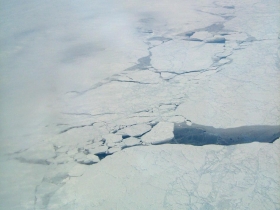Ocean Methane

Methane can be released to the atmosphere from a variety of natural and and made sources. The fragile and rapidly changing Arctic region is home to large reservoirs of methane, a potent greenhouse gas. As Earth's climate warms, the methane, frozen in reservoirs stored in Arctic tundra soils or marine sediments, is vulnerable to being released into the atmosphere, where it can add to global warming. Now a multi-institutional study by Eric Kort of NASA's Jet Propulsion Laboratory, Pasadena, Calif., has uncovered a surprising and potentially important new source of Arctic methane: the ocean itself.
Atmospheric methane levels are of interest due to its impact on climate change. Atmospheric methane is one of the most potent and influential greenhouse gases on Earth. The 100-year global warming potential of methane is 25, i.e. over a 100-year period, it traps 25 times more heat per mass unit than carbon dioxide.
Previously there have been many potential sources of atmospheric methane: Wetlands (20% - decomposition), animal flatulence and burps, forests, Arctic methane release and clathrate effect/permafrost, farming, natural gas releases or incomplete combustion, rice farming, and landfills.
Now there is a new potential methane source.
During five HIPPO flights over the Arctic from 2009 to 2010, Kort's team observed increased methane levels while flying at low altitudes over the remote Arctic Ocean, north of the Chukchi and Beaufort Seas. The methane level was about one-half percent larger than normal background levels.
But where was the methane coming from? The team detected no carbon monoxide in the atmosphere that would point to possible contributions from human combustion activities. In addition, based on the time of year, location and nature of the emissions, it was extremely unlikely the methane was coming from high-latitude wetlands or geologic reservoirs.
By comparing locations of the enhanced methane levels with airborne measurements of carbon monoxide, water vapor and ozone, they pinpointed a source: the ocean surface, through cracks in Arctic sea ice and areas of partial sea ice cover. The cracks expose open Arctic seawater, allowing the ocean to interact with the air, and methane in the surface waters to escape into the atmosphere. The team detected no enhanced methane levels when flying over areas of solid ice.
Kort said previous studies by others had measured high concentrations of methane in Arctic surface waters, but before now no one had predicted that these enhanced levels of ocean methane would find their way to the overlying atmosphere.
So how is the methane being produced? The scientists aren't yet sure, but Kort hinted biological production from living things in Arctic surface waters may be a likely culprit. "It's possible that as large areas of sea ice melt and expose more ocean water, methane production may increase, leading to larger methane emissions," he said. He said future studies will be needed to understand the enhanced methane levels and associated emission processes and to measure their total contribution to overall Arctic methane levels.
The study, was published April 22 in Nature Geoscience.
For further information see Arctic Methane
Arctic Ocean image via NASA.
©2012. Copyright Environmental News Network To subscribe or visit go to: http://www.enn.com